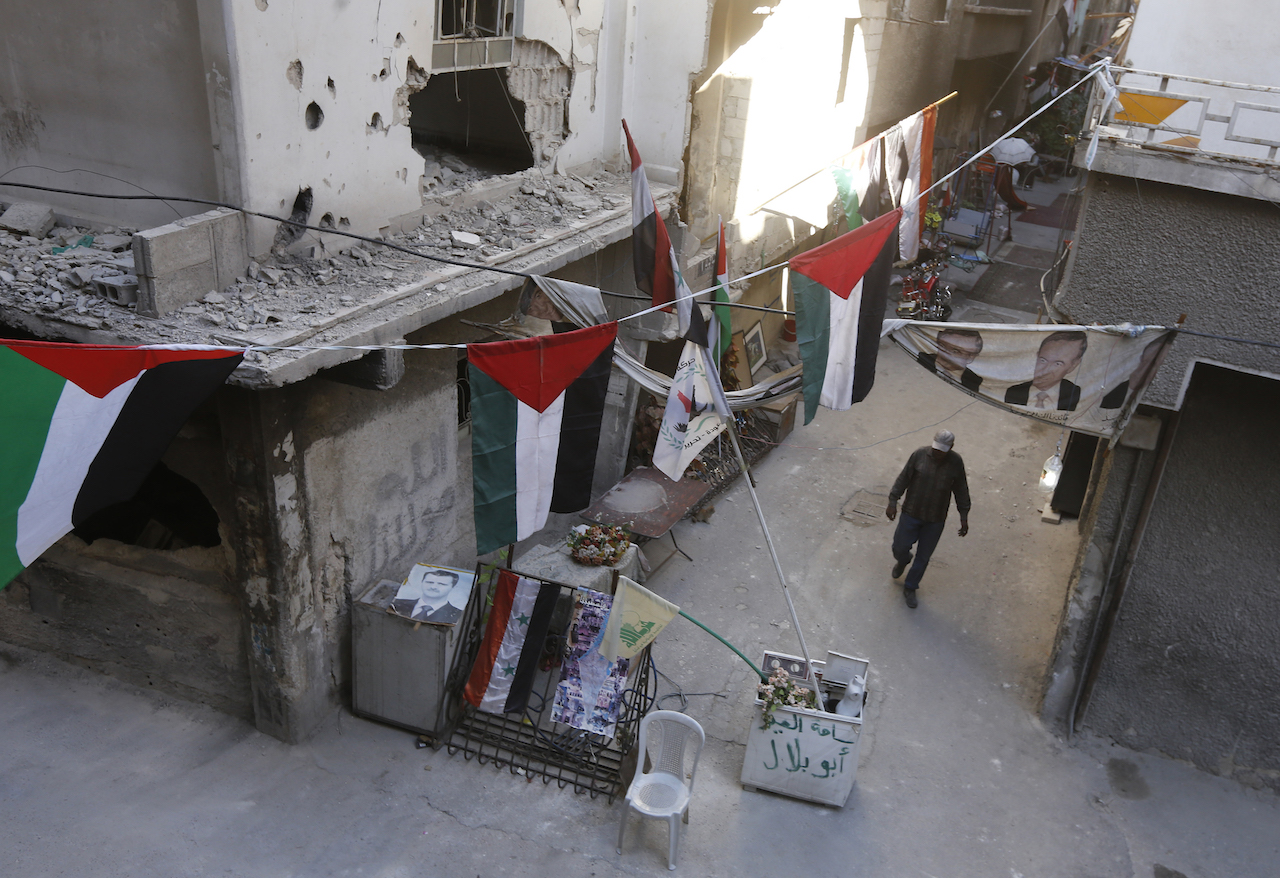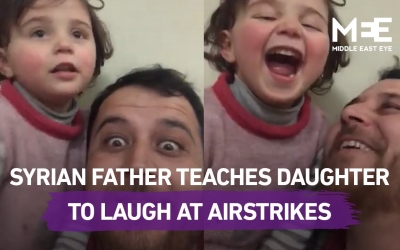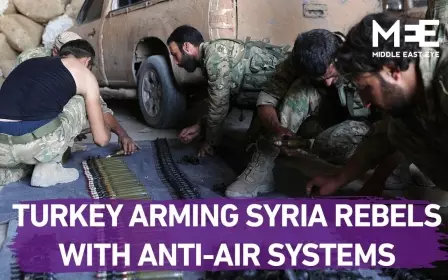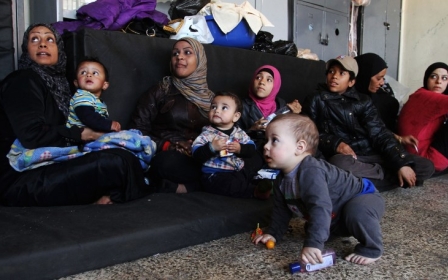'Poverty everywhere': Palestinians in Syria living in desperate conditions

Last year, Palestinian refugee Um Ammar* went back to Damascus for the first time in years.
After spending the past few years in a country neighbouring Syria (not named here in order to protect Um Ammar’s identity) she went back across the border to see friends and family.
Driving towards Damascus, she was surprised at how much everything cost, and the number of checkpoints on the road.
But it was only once Um Ammar got to Damascus that she realised how much the country had changed in her absence.
“The country is destroyed,” she told Middle East Eye, after returning to her new home in the neighbouring country.
New MEE newsletter: Jerusalem Dispatch
Sign up to get the latest insights and analysis on Israel-Palestine, alongside Turkey Unpacked and other MEE newsletters
"There is poverty everywhere.”
Things were particularly bad, Um Ammar noticed, among fellow Palestinians from Yarmouk.
Once Syria’s largest Palestinian community - more a fully fledged Damascene suburb than a refugee camp - Yarmouk lies in ruin after years of bombardment and siege.
Forces loyal to Syrian President Bashar al-Assad retook Yarmouk and the rest of the rebel-held regions in and around Damascus in May 2018.
Yarmouk, then under the control of Islamic State group militants, was subject to daily air strikes, artillery shelling and ground advances as part of that final offensive.
The camp is now almost completely empty, with many of its former residents having fled to other areas of the Syrian capital, as the socio-economic prospects at the camp are grim.
“The daughter of one of our neighbours [in the camp] ran out of money and couldn’t afford to pay the rent on her house or even buy food,” Um Ammar remembers.
“My sister found out after [our old neighbour] actually left her house, got rid of their belongings and started living in the street. So now my sister sends her money every month, from the Netherlands, to help out.”
Recently announced figures from UNRWA, the UN agency responsible for assisting Palestinian refugees in the Middle East, suggest that this is a far from an isolated incident, with almost all of the 438,000 Palestinian refugees still inside Syria living in absolute poverty.
Worsening conditions
According to UNRWA’s 2020 emergency appeal for the Syria crisis, “a socio-economic assessment of living conditions conducted by UNRWA in December 2017 estimated that 91 percent of Palestine refugee households in Syria live in absolute poverty”, meaning they earn the equivalent of less than $2 per day before receiving cash assistance from the agency.
And while the figures have only recently garnered attention in Arabic media - Damascus-based pro-government daily al-Watan splashed the figures last week - the numbers are not new.
That means poverty rates among Palestinian refugees in Syria may have actually worsened since UNRWA’s socio-economic assessment in late 2017.
'The Syrian pound has collapsed inside Syria … which has had a direct impact on [people’s] living conditions. That’s affecting everybody - not just the Palestinians'
- Wissam Sabaaneh, Jafra Foundation
UNRWA has faced a crisis of its own since US President Donald Trump’s administration decided to stop funding the agency, which was previously majority funded by Washington.
As a result, UNRWA was forced to cut its cash assistance programme in half and instead focus on supporting the most vulnerable cases in Syria.
Groups that the UN agency considers among the most vulnerable include families headed by women, disabled persons and the elderly.
However, the grim socio-economic prospects in the Palestinian community are far from something internal to UNRWA.
Syria is experiencing the beginnings of an acute economic crisis underpinned by a currency in freefall, which has almost certainly made matters worse for hundreds of thousands of Palestinian refugees still residing in Syria.
“The Syrian pound has collapsed inside Syria … which has had a direct impact on living conditions. That’s affecting everybody - not just the Palestinians,” explains Wissam Sabaaneh, head of the Jafra Foundation, a Palestinian-Syrian relief organisation that works within Palestinian communities in Syria, as well as Lebanon.
‘Everyone I know from Daraa is in this situation’
Daraa, known as the “cradle of the revolution” for its early role in the anti-Assad uprising, was home to a Palestinian camp that spread out from the city’s eastern outskirts.
The camp was part of the city, and it didn’t take long before Palestinians participated in protests alongside their Syrian neighbours.
Palestinian activist Abu Muhammad* says he participated in those early protests against Assad in March 2011, and later worked as an activist and relief worker after the southern half of the city - including the Daraa camp - fell to the opposition.
Unlike thousands of others who opted to evacuate to Syria's northwest after pro-government forces retook Daraa in mid-2018, Abu Muhammad stayed on. He said that the Palestinian community there was struggling.
“What UNRWA said is true, there is a great deal of poverty - more than you can imagine.”
“Everyone that I know from Daraa camp is in this situation, and the same goes for those living in Muzayreeb, Jaleen and Daraa,” he adds, naming smaller Palestinian communities in towns and villages dotted across the surrounding countryside.
“Their situation is the same. There is poverty, and increasing poverty on top of it.”
Abu Muhammad blames “increasing prices at the same time that there’s increasing employment”.
However, the wholesale destruction of several Palestinian communities during the war years has made things all the more difficult for refugees specifically.
Many of Syria’s Palestinian camps were emptied, or destroyed, during the course of the war.
Most Palestinian refugees still in Syria have experienced displacement, many of them more than once.
According to UNRWA data, there are currently 438,000 Palestinian refugees still residing in Syria, as well as tens of thousands who fled the country altogether and reside in neighbouring countries including Lebanon, Jordan and Turkey.
There are also a number of Palestinians in Syria’s rebel-held northwest, who fled northwards after the Syrian government and its allies started retaking one opposition-held territory after another following the fall of Daraya in late 2016.
“Most of the Palestinians that were living in Yarmouk camp, Daraa camp and other camps, [their camps] were destroyed, so people now have to afford rent for housing,” Jafra’s Sabaaneh says.
Um Ammar agrees. “It’s very difficult for people these days, especially since many have left their homes and the rents and prices are so expensive,” she explains.
“If people have relatives in Europe, then it’s possible that they’ll send 100 euros per month - and actually a lot of people get help this way, through those who travelled before. Those without people in Europe may turn to begging instead.”
Um Ammar shares an image of her neighbour, who’d sold her house for lack of funds and started begging on the streets of Syria’s capital.
The photo shows an emaciated, exhausting-looking figure lying on the bed of a Damascus hospital.
“This is just one story of the people of the camp,” Um Ammar says.
* Names have been changed in this article to protect identities
This article is available in French on Middle East Eye French edition.
Middle East Eye delivers independent and unrivalled coverage and analysis of the Middle East, North Africa and beyond. To learn more about republishing this content and the associated fees, please fill out this form. More about MEE can be found here.






